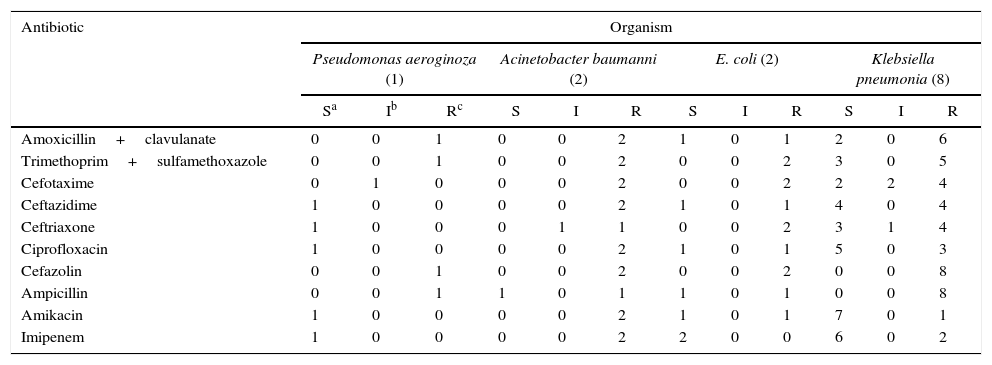Hospital-acquired bacterial pneumonia (HABP) is one of the most important acute complications that affects patients admitted to intensive care units (ICU) developing mainly in patients receiving mechanical ventilation for more than 48hours with an incidence of 9–27%.1,2 It is commonly caused by species of the Enterobacteriaceae family, non-fermentative Gram-negative bacilli, and Staphylococcus aureus.3,4 The awareness of the HABP and antimicrobial resistance patterns are necessary to improve hospital infection control system, selecting appropriate empirical antibiotics, reducing duration of ICU admission, decreasing costs of hospitalization, application of effective methods for preventing and controlling of HABP and finally to reduce the mortality and morbidity rates in these patients.
A cross-sectional study designed from January 2013 till January 2014 included all 16 patients admitted to the ICU with HABP requiring mechanical ventilation for at least 48hours in a general hospital in south of Iran were included. Samples were cultured on blood agar & EMB agar. Colony counts of more than 104cfu/mL were considered positive.
Diagnostic tests applied API-20E commercial kit for Gram-negative bacilli & API-20NE for Gram-negative non-fermentative bacilli. Staphylococci were identified by Gram stain, morphology, catalase, bacitracin sensitivity, coagulase test with fresh plasma from Darvash® Company, DNase activity, and mannitol fermentation. Susceptibility of all isolates to different antibiotics were performed with Kirby-Bauer disk diffusion method on Muller-Hinton agar plates. Results were interpreted according to the standards provided by National Committee for Clinical Laboratory Standards (NCCLS, 2003) (Table 1).
Frequency of antibiotic resistance among gram negative bacterial isolates in the study.
| Antibiotic | Organism | |||||||||||
|---|---|---|---|---|---|---|---|---|---|---|---|---|
| Pseudomonas aeroginoza (1) | Acinetobacter baumanni (2) | E. coli (2) | Klebsiella pneumonia (8) | |||||||||
| Sa | Ib | Rc | S | I | R | S | I | R | S | I | R | |
| Amoxicillin+clavulanate | 0 | 0 | 1 | 0 | 0 | 2 | 1 | 0 | 1 | 2 | 0 | 6 |
| Trimethoprim+sulfamethoxazole | 0 | 0 | 1 | 0 | 0 | 2 | 0 | 0 | 2 | 3 | 0 | 5 |
| Cefotaxime | 0 | 1 | 0 | 0 | 0 | 2 | 0 | 0 | 2 | 2 | 2 | 4 |
| Ceftazidime | 1 | 0 | 0 | 0 | 0 | 2 | 1 | 0 | 1 | 4 | 0 | 4 |
| Ceftriaxone | 1 | 0 | 0 | 0 | 1 | 1 | 0 | 0 | 2 | 3 | 1 | 4 |
| Ciprofloxacin | 1 | 0 | 0 | 0 | 0 | 2 | 1 | 0 | 1 | 5 | 0 | 3 |
| Cefazolin | 0 | 0 | 1 | 0 | 0 | 2 | 0 | 0 | 2 | 0 | 0 | 8 |
| Ampicillin | 0 | 0 | 1 | 1 | 0 | 1 | 1 | 0 | 1 | 0 | 0 | 8 |
| Amikacin | 1 | 0 | 0 | 0 | 0 | 2 | 1 | 0 | 1 | 7 | 0 | 1 |
| Imipenem | 1 | 0 | 0 | 0 | 0 | 2 | 2 | 0 | 0 | 6 | 0 | 2 |
The frequency of extended spectrum beta-lactamase (ESBL) producing isolates were considered with double disk synergy test (DDST) for detection of methicillin-resistant Staphylococcus aureus (MRSA). Overall, the mortality rate of ICU patients during the study period was 62% whereas the case fatality rate (CFR) of HABP was 25% (4/16) with an attributable mortality rate was 6.45%.
The risk factors for HABP mortality were: (1) male gender; (2) increasing age; (3) underlying diseases (diabetes and cardiovascular diseases); (4) MRSA colonization of the respiratory tract; (5) invasive procedures; (6) resistance to cephalosporins, carbapenems, and aminoglycosides (especially in Acinetobacter spp and Klebsiella spp).
In last decade, highly resistant molecularly proved nosocomial infections to broad spectrum antibiotics probably due to production of betalactamases (for cephalosporins) or aminoglycoside modifying enzymes (AME) have emerged in our area. In this study Acinetobacter and Klebsiella resistance was due to production of betalactamase and carbapenemase which could highlight that Acinetobacter could be emerging as a multidrug resistant organism (XDR-AB), confirmed by the presence of the metallo-β-lactamase (MBL) and OXA genes. K. pneumoniae (Kp) producing carbapenemase (KPC) are associated with difficult to treat infections, and high mortality requiring combination therapy with carbapenems to improve survival. Therefore, Kp should not be overlooked as its resistance is emerging (25% of isolates were KPC producing) and the Kp infections are advised to be controlled with caution and using combination of a carbapenem, tigecycline, and colistin5 to lower mortality.
HAI, if not properly controlled, increase in mortality rates, treatment costs, and reduces life span. Awareness of the resistance mechanism could lead to adequate prescription and ways to eliminate the resistance must be sought.
Conflicts of interestThe authors declare no conflicts of interest.






